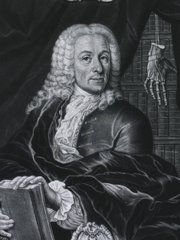
Medical Terminology Daily (MTD) is a blog sponsored by Clinical Anatomy Associates, Inc. as a service to the medical community. We post anatomical, medical or surgical terms, their meaning and usage, as well as biographical notes on anatomists, surgeons, and researchers through the ages. Be warned that some of the images used depict human anatomical specimens.
You are welcome to submit questions and suggestions using our "Contact Us" form. The information on this blog follows the terms on our "Privacy and Security Statement" and cannot be construed as medical guidance or instructions for treatment.
We have 389 guests online

Georg Eduard Von Rindfleisch
(1836 – 1908)
German pathologist and histologist of Bavarian nobility ancestry. Rindfleisch studied medicine in Würzburg, Berlin, and Heidelberg, earning his MD in 1859 with the thesis “De Vasorum Genesi” (on the generation of vessels) under the tutelage of Rudolf Virchow (1821 - 1902). He then continued as a assistant to Virchow in a newly founded institute in Berlin. He then moved to Breslau in 1861 as an assistant to Rudolf Heidenhain (1834–1897), becoming a professor of pathological anatomy. In 1865 he became full professor in Bonn and in 1874 in Würzburg, where a new pathological institute was built according to his design (completed in 1878), where he worked until his retirement in 1906.
He was the first to describe the inflammatory background of multiple sclerosis in 1863, when he noted that demyelinated lesions have in their center small vessels that are surrounded by a leukocyte inflammatory infiltrate.
After extensive investigations, he suspected an infectious origin of tuberculosis - even before Robert Koch's detection of the tuberculosis bacillus in 1892. Rindfleisch 's special achievement is the description of the morphologically conspicuous macrophages in typhoid inflammation. His distinction between myocardial infarction and myocarditis in 1890 is also of lasting importance.
Associated eponyms
"Rindfleisch's folds": Usually a single semilunar fold of the serous surface of the pericardium around the origin of the aorta. Also known as the plica semilunaris aortæ.
"Rindfleisch's cells": Historical (and obsolete) name for eosinophilic leukocytes.
Personal note: G. Rindfleisch’s book “Traité D' Histologie Pathologique” 2nd edition (1873) is now part of my library. This book was translated from German to French by Dr. Frédéric Gross (1844-1927) , Associate Professor of the Medicine Faculty in Nancy, France. The book is dedicated to Dr. Theodore Billroth (1829-1894), an important surgeon whose pioneering work on subtotal gastrectomies paved the way for today’s robotic bariatric surgery. Dr. Miranda.
Sources:
1. "Stedmans Medical Eponyms" Forbis, P.; Bartolucci, SL; 1998 Williams and Wilkins
2. "Rindfleisch, Georg Eduard von (bayerischer Adel?)" Deutsche Biographie
3. "The pathology of multiple sclerosis and its evolution" Lassmann H. (1999) Philos Trans R Soc Lond B Biol Sci. 354 (1390): 1635–40.
4. “Traité D' Histologie Pathologique” G.E.
Rindfleisch 2nd Ed (1873) Ballieres et Fils. Paris, Translated by F Gross
"Clinical Anatomy Associates, Inc., and the contributors of "Medical Terminology Daily" wish to thank all individuals who donate their bodies and tissues for the advancement of education and research”.
Click here for more information
- Details
This compound term is Latin, from [bifurcus] meaning double-pronged. The prefix [bi-] means "two" or "double", and the root [-furcat- ], derived from the Latin [furca] meaning "a fork". Bifurcation means "to fork into two".
In anatomy the term is used to denote the splitting of a structure into two, such as the "bifurcation of the aorta". A variation of the term is "bifid".
- Details
The aorta is the main and largest artery of the systemic portion of the circulatory system. It is one of the great vessels of the heart. It starts at the ventriculoaortic anulus and ends at its bifurcation of the aorta in front of the body of the 4th lumbar vertebra. At this point the aorta is continuous with the left and right common iliac arteries.
The aorta has four segments: ascending aorta, aortic arch, descending or thoracic aorta, and abdominal aorta.
The etymology of the term [aorta] is not clear. The first reference of this structure is from Aristotle, who uses the word "aorta", although in the same work he refers to it as the "tendinous vein". Adrian Van Der Spigelius (1578 - 1625) mentions that the name aorta was given to the curved sheath of a Macedonian knife which has a pronouncedly curved handle (the aorta has a pronounced curve at the aortic arch). Yet another interpretation comes from the Greek, where a similar word means a "curved shoulder strap".
Sources:
1. "The origin of Medical Terms" Skinner, AH, 1970
2. "Medical Meanings" Haubrich, William S. Am Coll Phys Philadelphia 1997
- Details
This term is incorrectly spelled [annulus] in most literature. The proper term [anulus] is a derivative of Latin and means "ring" or "circle". The term anulus was adopted by anatomists worldwide in 1955, with the publication of the Nomina Anatomica (Paris). The plural for for anulus is anuli.
There are many ring-like structures or anuli in the human body:
- anulus inguinalis superficialis: Superficial inguinal ring
- anulus inguinalis profundus: Deep inguinal ring
- anulus fibrosus: Center region of an intervertebral disc
- anulus lymphaticus pharyngis: Pharyngeal lymphoid ring or ring of Waldeyer , etc.
Sources:
1. "The origin of Medical Terms" Skinner, AH, 1970
2. "Terminologia Anatomica: International Anatomical Terminology (FCAT)" Thieme,1998
3. "Gray's Anatomy"38th British Ed. Churchill Livingstone 1995
4. "The Doctor's Dyslexicon" Dirckx, JH;Am J Dermatopathol 2005;27:86–88
- Details
This article is part of the series "A Moment in History" where we honor those who have contributed to the growth of medical knowledge in the areas of anatomy, medicine, surgery, and medical research.
Lorenz Heister (1683-1758) A German surgeon, physician, anatomist, and botanist, Lorenz Heister [also known as Laurentius Heisterus] was born at Frankfurt-am-Main in 1683. As a result of his early studies, he became proficient in Latin, French, English and Dutch. He started medical studies at the University of Giessen, later continuing in Amsterdam, and Leyden, where he obtained his MD degree in 1708.
For a short time Heister became an army surgeon. In 1710 he was appointed Professor of Anatomy and Surgery at the University of Altfdorf. Although he lectured in Latin, Heister published his anatomical treatise “Compendium Anatomicum” in German in 1718. Later, Latin, French, Italian, and Spanish translations were created and published. Heister’s book became the main anatomical and surgical textbook in Europe. The English version was first published in 1743.
Heister is considered the “Father of German Surgery”, including in his books the management of hemorrhage, wounds, fractures, bandaging, instrumentation, and surgery. Heister described the surgical treatment of breast cancer, hemothoraces, spinal fractures, trepanation, oral surgery, and even obstetrical emergencies. He introduced the term “tracheotomy.” Heister also studied the eye, confirming that cataracts are formed within the lens.
His name is remembered eponymically in two structures:
- Heister’s valve (plica spiralis) a spiral fold of mucosa found in the cystic duct
- Heister’s diverticulum (bulbus superius venae jugularis interna), a dilation of the internal jugular vein found at its origin from the jugular foramen of the base of the cranium
Heister's name is spelled Heisters, in his "Compendium Anatomicum" published in 1756.
Sources:
1. "Heister of the spiral valve of Heister - Lorenz Heister" Gastroenter Hepat News (2006): 131 (3) 696.
2. “Lorenz Heister: Surgeon (1683-1758)” Stewart, J. Can Med Assoc J. 1929 20(4): 418–419.
3. "Lorenz Heister (1683-1758). Eighteenth century surgeon" JAMA 202 (11), 1048-1049
4. "Lorenz Heister and oral disease with the original text from his papers". Shklar , G. J Hist Dent (2007); 55:2 68-74
- Details
The suffix [-(o)plasty] has a Greek origin and means "formed or molded". It is used in surgery to denote a surgical repair where the organ or body part is re-formed. For practical purposes, a great definition for this suffix is "surgical reshaping".
If an organ or body part is surgically manipulated, cut, or opened, then there are two ways to repair the damage. The first one is to repair and leave it exactly as it was before the operation. The proper suffix to use in this case is [-orrhaphy], meaning "repair". The second case is when the organ has been repaired in such a way that is different in shape than when the operation started. In this case the proper suffix to use is [-oplasty].
Some applications of this suffix are:
- Hernioplasty: Surgical reshaping of a hernia
- Abdominoplastly: Surgical reshaping of the abdomen
- Rhinoplasty: Surgical reshaping of the nose
- Aneurysmoplasty: Surgical reshaping of an aneurysm
- Mammoplastly: Surgical reshaping of the breast
- Details
A serosa is a type of epithelium embryologically derived from the mesoderm, thus a serosa can also be called a [mesothelium]. Serosal membranes are found forming sacs that surround structures in the body, such as the pericardium, pleural membranes, and peritoneum.
Serous membranes are characterized by a thin single-layer mesothelium covering a layer of vascularized loose connective tissue. A serosa produces (and absorbs) a watery fluid called "serous fluid" which serves to lubricate organs that require movement such as the heart, lungs and digestive tract : pericardial fluid, pleural fluid, and peritoneal fluid.
The excess production (effusion) of serous fluid can cause serious pathology, such as pericardial tamponade, hydrothorax, or ascitis (peritoneal effusion)


